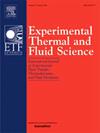High-speed impact of water droplets on microtextured surfaces: Effect of roughness and wettability on corona splashing
IF 3.3
2区 工程技术
Q2 ENGINEERING, MECHANICAL
Experimental Thermal and Fluid Science
Pub Date : 2025-09-11
DOI:10.1016/j.expthermflusci.2025.111618
引用次数: 0
Abstract
A study of the high-speed impact of water droplets on smooth and microtextured fluoropolymer-coated titanium surfaces is presented. The experimental samples had an average roughness Ra from 0.04 μm to 15.4 μm and a static contact angle θ from 74° to 164°. The 0.5–1.3-mm droplets were impacted on the surfaces at velocities U0 = 5–20 m/s (the Weber number We = 450–2,800). Using a high-speed video camera with a sample rate of 60,000 frames per second, the values of the opening angle α, the maximum diameter Dcor, and the lifetime of the corona were measured and analyzed. In addition, the mean splashing velocities of both large and small secondary fragments were captured. A dimensionless ratio, α/θ, which characterizes the predominance of inertial or adhesive forces, was proposed for the development of an empirical model for predicting Dcor. This model was validated using data from other authors, which proved its applicability in the ranges of We = 450–2,800, Ra = 1.05–38 µm, θ = 69–164° (water) and θ 0° (ethanol). The research elucidated that superhydrophobic microtextured surfaces provide greater symmetry in corona splash and a larger opening angle. However, these surfaces also delayed liquid removal during splashing, which has the potential to impact the effectiveness of their water-repellent properties.

水滴对微纹理表面的高速冲击:粗糙度和润湿性对电晕飞溅的影响
研究了水滴对光滑和微纹理含氟聚合物涂层钛表面的高速冲击。实验样品的平均粗糙度Ra为0.04 ~ 15.4 μm,静态接触角θ为74 ~ 164°。0.5 ~ 1.3 mm液滴以U0 = 5 ~ 20m /s(韦伯数We = 450 ~ 2800)的速度撞击表面。利用60000帧/ s的高速摄像机,测量和分析了日冕的开启角α、最大直径Dcor和寿命。此外,还获得了大碎片和小碎片的平均飞溅速度。提出了一个无量纲比α/θ,它表征了惯性力或附着力的优势,用于开发预测Dcor的经验模型。该模型在We = 450 ~ 2800, Ra = 1.05 ~ 38µm, θ = 69 ~ 164°(水)和θ≈0°(乙醇)范围内的适用性得到验证。研究表明,超疏水微织构表面提供了更大的电晕飞溅对称性和更大的开口角。然而,这些表面也延迟了飞溅过程中液体的去除,这有可能影响其防水性能的有效性。
本文章由计算机程序翻译,如有差异,请以英文原文为准。
求助全文
约1分钟内获得全文
求助全文
来源期刊

Experimental Thermal and Fluid Science
工程技术-工程:机械
CiteScore
6.70
自引率
3.10%
发文量
159
审稿时长
34 days
期刊介绍:
Experimental Thermal and Fluid Science provides a forum for research emphasizing experimental work that enhances fundamental understanding of heat transfer, thermodynamics, and fluid mechanics. In addition to the principal areas of research, the journal covers research results in related fields, including combined heat and mass transfer, flows with phase transition, micro- and nano-scale systems, multiphase flow, combustion, radiative transfer, porous media, cryogenics, turbulence, and novel experimental techniques.
 求助内容:
求助内容: 应助结果提醒方式:
应助结果提醒方式:


